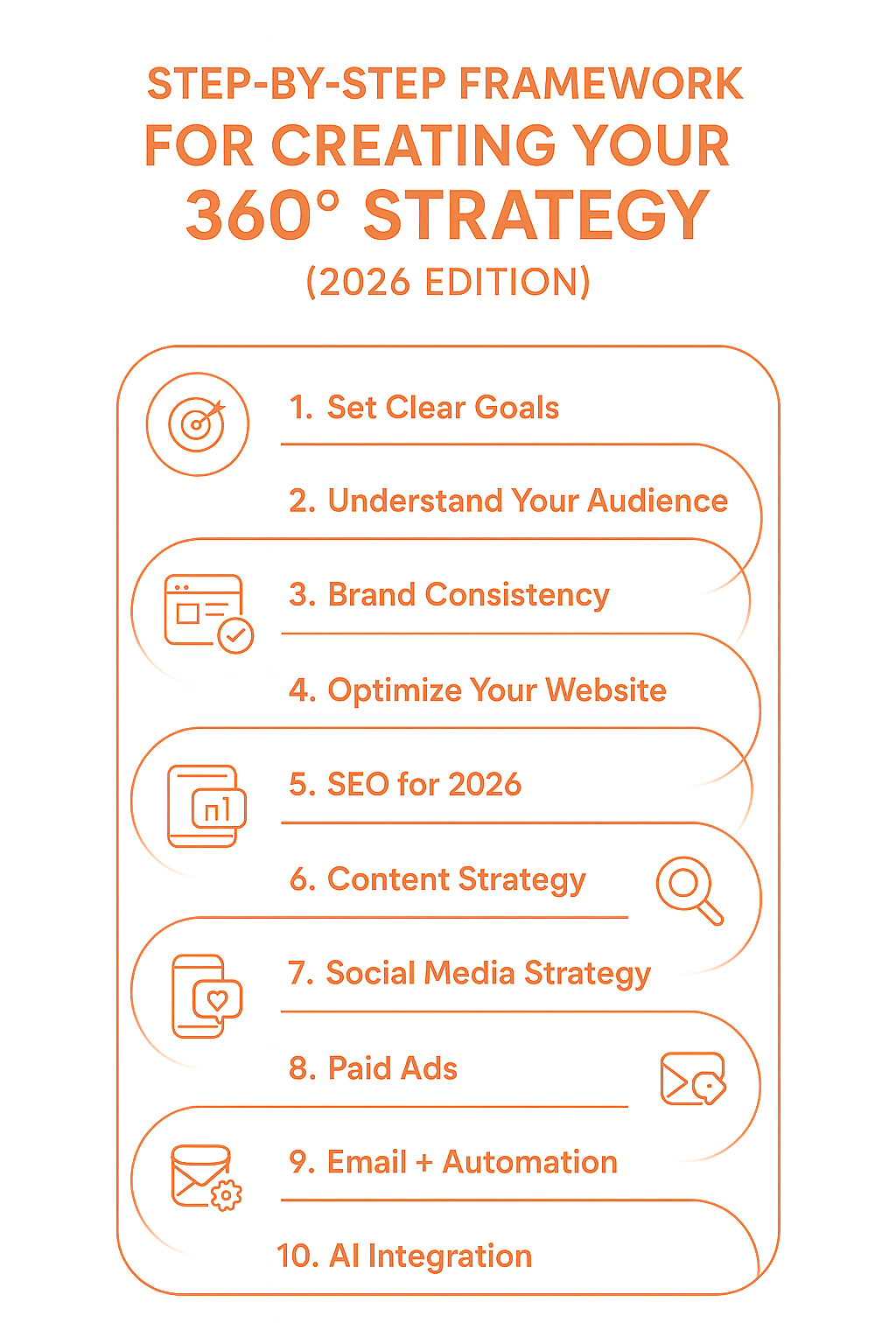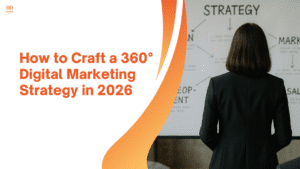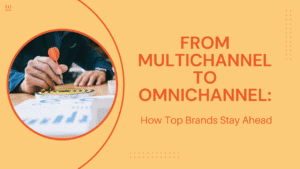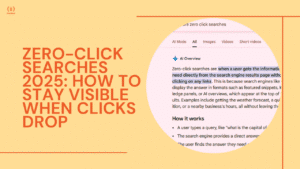Digital marketing in 2026 is noisy, crowded, and algorithm-dependent. Every platform is powered by AI. Search is shifting to LLMs. Consumers expect personalisation, speed, and omnichannel interaction.
People switch between platforms over 22 times before making a purchase. They prefer micro-moments over long attention spans. They trust authenticity over polished advertising. And they demand consistency across every touchpoint.
This is why brands that still use siloed marketing strategies feel stuck:
- Social media engagement is inconsistent
- Ads don’t convert the way they used to
- Website traffic isn’t translating to revenue
- Email campaigns feel outdated
- Content gets lost in overcrowded feeds
Meanwhile, brands that adopt a 360° digital marketing strategy grow 3–7X faster because they create a connected ecosystem where every channel supports the next.
In this guide, we’ll walk through—step by step—how to design a powerful, modern 360° marketing strategy for 2026.
What a 360° Digital Marketing Strategy Actually Means
Most marketers confuse “multichannel” with “360°.”
But they’re not the same.
Multichannel = you’re present on many channels
360° strategy = those channels work together seamlessly
Think of it like this:
| Strategy Type | How It Works | Drawback | Benefit |
| Single-channel | One platform (e.g., only Instagram) | Very limited growth | Easy to manage |
| Multichannel | Active on many channels | No consistency | Wider reach |
| Omnichannel / 360° | All channels work together | Requires planning | Highest ROI + conversions |
A 360° marketing strategy integrates awareness, consideration, conversion, and retention across every channel—both organic and paid.
A true 360° strategy ensures that:
- Your messaging is aligned everywhere.
- Your audience sees the same tone, values, and experience.
- Data from one channel improves performance in another.
- Users feel like they’re on one consistent journey, not scattered steps.
For example:
A customer might see your TikTok video → Google your brand → land on your website → sign up for your email list → click a retargeting ad → finally buy after reading your reviews.
Why Your Business Needs a 360° Strategy Now
Brands are no longer discovered in a single place by customers. They hop back and forth between Google, Facebook/Instagram, AI tools, reviews, and videos before deciding. If your business doesn’t show up across these touchpoints, there’s a chance they’ll choose another company instead.
A 360° approach ensures your brand is always present, reliable, and trustworthy across every touchpoint. It integrates your ads, content, SEO, email, and social efforts into one seamless experience — so customers see the same message wherever they go.
Here’s why you need it now:
- People need multiple touchpoints before they’re willing to trust a brand.
- Consistent messaging on all channels builds credibility and confidence.
- AI search is transforming how customers find and choose businesses.
- Relying on only one channel is far too risky today.
- A 360° strategy delivers consistent and predictable growth.
In other words, a 360° strategy helps your business stay visible, trusted, and competitive — no matter how the digital landscape evolves.
How to Build Your 360° Digital Marketing Strategy

Now that you understand how people think and engage with brands in 2026, it’s time to build the strategy. A strong 360° marketing system starts with clear goals and a defined audience, then unifies your website, SEO, content, social media, email, ads, and AI tools so everything works together to bring in and convert customers.
Let’s build yours step by step.
1. Set Clear Goals
A 360° strategy must have measurable, trackable, realistic goals. Before you launch campaigns, create content, or design ads, you need to define your goals. Clear goals are the engine of your 360° marketing system. They tell you where to put your resources, what to measure, and how to optimize.
Good goals start with clarity.
Ask:
- Do we want brand awareness or conversions?
- What exact numbers define success?
- Which platform will give us the highest ROI?
- What time frame do we expect results in?
Example of Smart Goals:
- “Grow website traffic from 5,000 to 20,000 monthly visits by July 2026.”
- “Generate 500 qualified leads per month through email funnels.”
- “Increase Instagram engagement by 30% in 90 days.”
Use tools like:
- Google Analytics 4
- Heatmaps
- UTM tracking
- Marketing dashboards
- AI-driven attribution tools
When you set goals the right way, every channel becomes more strategic, measurable, and predictable.
2. Understand Your Audience
You can’t build a great marketing strategy if you don’t deeply understand the people you’re selling to. In 2026, audience research goes beyond demographics. You must understand behaviors, motivations, fears, and how they search (especially using AI).
Persona Building in 2026
Personas are no longer just demographic lists — they’re behavior-driven profiles.
A modern persona includes:
- Demographics: age, gender, location, profession
- Psychographics: beliefs, values, motivations
- Tech behavior: devices, platforms, and AI tools they use
- Content preferences: short-form, long-form, visual, audio
- Pain points: what keeps them stuck
- Buying triggers: what makes them take action
Example persona snippet:
“Ava, 32, searches using AI assistants, prefers TikTok for reviews, trusts creators more than brand ads, values authenticity, and buys after comparing 2–3 sources.”
This kind of detail powers your entire strategy.
Customer Research Tools:
- Google Analytics 4
- Meta Audience Manager
- TikTok Insights
- YouTube Analytics
- Customer surveys
- Heatmaps (Hotjar, Clarity)
These reveal what your audience wants even if they never say it directly.
3. Build Brand Consistency Across All Channels
Brand consistency is the backbone of a strong 360° digital marketing strategy. When your audience sees your content on TikTok, your emails, your website, and inside Google’s AI search results, they should immediately recognize that it’s you. This recognition builds trust — and trust builds conversions.
In a 360° strategy, consistency is your anchor.
What Brand Consistency Means
Consistency isn’t just using the same logo or colors. It’s about creating a unified brand experience wherever your audience sees you.
This includes:
- Brand voice
- Visual identity
- Tone and persona
- Messaging pillars
- Value proposition
- Story and purpose
- Offers and CTAs
When your message stays consistent across every channel, two powerful things happen:
- People trust you faster.
- AI systems identify you as a cohesive brand and boost visibility.
Creating a Brand Experience
A powerful 360° brand feels the same everywhere.
Example:
If you’re energetic on TikTok but corporate on your website, the disconnect creates friction. Customers feel confused, not confident.
To maintain consistency:
- Build a messaging guide
- Create reusable templates
- Keep tone aligned across all written content
- Standardize brand colors and layout styles
- Use consistent storytelling frameworks
Consistency checklist:
- Does my Instagram bio match my website?
- Do all platforms reflect the same brand voice?
- Are visuals unified in color, typography, and spacing?
- Are content themes aligned?
4. Optimize Your Website
Your website is the center of your 360° strategy.
If your website is slow, unclear, or poorly optimized, every other channel suffers.
Improve:
- Loading speed
- Mobile responsiveness
- SEO structure
- CTA clarity
- Copywriting
- Design and branding
- Navigation
Must-have pages in 2026:
- High-conversion homepage
- SEO blog hub
- Services / Products
- Testimonials
- Resources
- Landing pages (at least 3–5)
Website Benchmarks
| Metric | Ideal Target |
| Loading speed | Under 2.5 seconds |
| Homepage bounce rate | < 45% |
| Top landing page CVR | 3–6% |
| Scroll depth | 60–80% |
Key Takeaways
- Your website is the most important asset in 2026.
- A slow website destroys conversions.
- Website optimization directly boosts every other channel.
5. SEO Strategy for 2026: What’s Changed & What Still Works
SEO in 2026 is a different beast. The rules have changed, but the goal remains the same: be the best answer on the internet. With search engines evolving, especially with AI-powered results, your SEO strategy must be smarter, deeper, and more human.
SEO in 2026 is heavily influenced by:
- AI search (Google Gemini, Perplexity, ChatGPT Search)
- Search intent evolution
- User experience
- EEAT (Experience, Expertise, Authoritativeness, Trustworthiness)
What’s Changed in 2026?
SEO has shifted dramatically—here are the biggest changes you must adapt to:
1. AI-Generated Search Results
Search engines now provide AI summaries, meaning your content must be:
- fact-rich
- structured
- snippet-friendly
- formatted with bullet points, steps, and tables
2. Topic Authority Is Everything
Google rewards websites that go deep into topics, not those that post random blogs every week.
3. Visual & Voice Search Are Growing
People search with photos, voice queries, and short prompts more than ever.
4. Helpful Content Is Mandatory
Content must demonstrate:
- real expertise
- firsthand experience
- actionable advice
- unique insights
What Still Works
Despite the changes, several SEO fundamentals remain powerful:
- backlink building
- keyword research
- internal linking
- long-form content
- E-E-A-T (Experience, Expertise, Authority, Trustworthiness)
- fast-loading pages
SEO Essentials Table
| SEO Area | What You Must Do | Importance |
|---|---|---|
| AI Search | Add structured answers, lists, tables | High |
| Helpful Content | Add firsthand experience | High |
| Technical SEO | Fast speed, clear structure | High |
| Topic Authority | Build content clusters | High |
| Backlinks | Earn links from credible sources | Medium |
SEO in 2026 rewards brands that are real, helpful, experienced, and consistent.
If you create deep, trustworthy content and optimize for AI search, you’ll win—no matter how competitive your niche is.
6. Content Strategy (Your 2026 Superpower)
A 360° strategy only works if you publish content consistently. But consistency doesn’t mean posting every day—it means posting strategically.
Your 2026 content ecosystem should include:
- Long-form SEO blogs
- Short-form videos
- Carousel explainers
- YouTube educational videos
- Infographics
- Email newsletters
- Case studies
- Lead magnets
Use the “Core-to-Micro” Method:
- Create one long-form content piece weekly (blog or video)
- Break it into:
- 5 reels
- 2 carousels
- 10 tweets
- 1 newsletter
- 1 lead magnet teaser
- 5 reels
This maximizes output without burning out.
7. Social Media Strategy (2026 Edition)
Social media in 2026 is noisy, competitive, and ever-changing. But it’s also the fastest way to build trust, community, and brand visibility. To win, you need to stop posting random content and start building a structured cross-platform strategy that ties directly into your 360° system.
Platforms that matter most:
- Instagram
- TikTok
- YouTube
- LinkedIn
- Pinterest
- WhatsApp Channels
What works now:
- Short videos with hooks
- Behind-the-scenes storytelling
- Case study content
- Carousel explainers
- Authentic, raw content
Social Funnel:
- HOOK (Reels)
- VALUE (Carousels)
- TRUST (Stories + BTS)
- CONVERT (DMs + Link in Bio)
8. Paid Ads (High-ROI 2026 Approach)
Organic content builds trust.
Paid ads accelerate growth.
In 2026, the smartest brands use ads not to “sell instantly,” but to guide customers through a clear funnel. When you combine paid ads + organic content + SEO + email, you get a true 360° system.
Let’s break it down.
Meta Ads Strategy (Facebook + Instagram)
Meta ads still deliver the highest ROI for most businesses in 2026—especially for retargeting.
What works best:
- short videos (6–10 seconds)
- UGC-style ads
- testimonial ads
- problem/solution hooks
- simple headlines (“Stop wasting money on ads…”)
Funnel Example:
- Top of Funnel (TOF) – reach new audiences
- Reels-style videos
- Broad targeting
- Reels-style videos
- Middle of Funnel (MOF) – warm up visitors
- Case studies
- Benefit-focused ads
- Case studies
- Bottom of Funnel (BOF) – convert buyers
- Testimonials
- Discounts
- Product demos
- Testimonials
TikTok Ads Strategy
TikTok ads feel native—they blend in with regular content. That’s the key to success.
What works:
- raw, real videos
- natural movement (no stiff talking-head clips)
- humor + fast pacing
- trending sounds
- 5–9 second videos
Best TikTok ad formats:
- Spark Ads
- In-feed ads
- UGC-style testimonials
- Duet-style product demonstrations
Google Ads Strategy
Google ads work best for:
- high-intent searches
- local businesses
- ecommerce
- service providers
Types to use in 2026:
- Search campaigns
- Performance Max
- Local service ads
- Retargeting campaigns
Ads shouldn’t replace organic content—ads should amplify it. The highest ROI comes from combining both.
9. Email + Automation
Email is not outdated.
In fact, email in 2026 is more powerful because it’s one of the few channels you own.
Social media platforms can change.
Algorithms shift.
AI search results evolve.
But your email list stays with you forever.
Must-have email automations:
- Welcome sequence
- Lead magnet delivery
- Nurture sequence
- Abandoned cart sequence
- Post-purchase follow-ups
- Review request automation
Pro tip:
Create persona-specific drip funnels.
10. Integrate AI Across All Marketing Channels
AI is not replacing marketers—it’s empowering them.
When used correctly, AI makes your marketing faster, smarter, and more effective.
Use AI for:
- Predictive customer behavior
- Content repurposing
- Personalization
- Chatbots
- Segmentation
- Market analysis
- Real-time recommendations
Must-have AI tools:
- Jasper / Writesonic
- Midjourney or Adobe Firefly
- HubSpot AI
- GA4 insights
- Meta Advantage+
Key Takeaways
- AI gives you speed, insights, and personalization at scale.
- Automation + human creativity = unmatched performance.
Best 360° Channels & Tools for 2026
| Category | Tools |
| SEO | Ahrefs, Semrush, Surfer SEO, Screaming Frog |
| Social | Canva, CapCut, Metricool |
| Content | Notion, Google Docs |
| Analytics | GA4, Hotjar |
| Email Marketing & Automation | Klaviyo, Mailchimp, ConvertKit, HubSpot Email |
| AI | ChatGPT, Claude, Jasper, Perplexity |
Common Mistakes in 360° Marketing
- Posting without a strategy
- Being inconsistent with messaging
- Focusing too much on trends
- Ignoring email marketing
- Expecting instant results
- Not tracking KPIs
- Using too many tools—creating complexity
Conclusion
A 360° digital marketing strategy isn’t about doing everything — it’s about making every channel work together. When your content, ads, SEO, email, and social media all point toward the same goal, you create a brand experience that feels seamless, strong, and unforgettable.
Start small. Build consistently. Optimise continuously.
And remember — brands that win aren’t the ones that do the most…
They’re the ones that do the right things, in the right order, with the right strategy.
Don’t wait for results—create them. Contact us today, and let’s build your 2026 growth engine together.
FAQs
It’s a plan where all your channels—social media, SEO, content, ads, email, and AI—work together to guide customers from first discovery to purchase.
People check multiple platforms before buying. A 360° strategy makes your brand consistent, trusted, and easy to find everywhere.
Yes! Start with a few key channels and expand. Integration and consistency matter more than budget.
You can see initial results in 2–4 months, but full impact usually takes 3–6 months.
AI can automate tasks, personalize messages, and analyze data, making your marketing faster and smarter.





